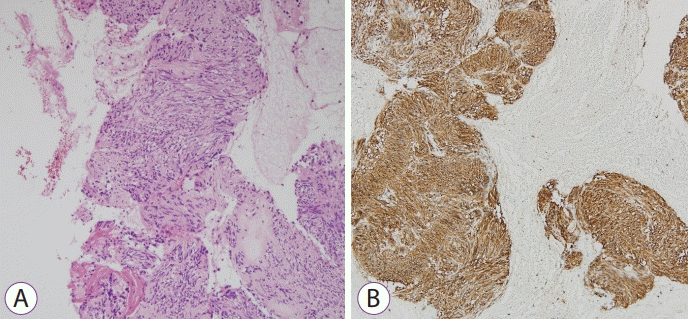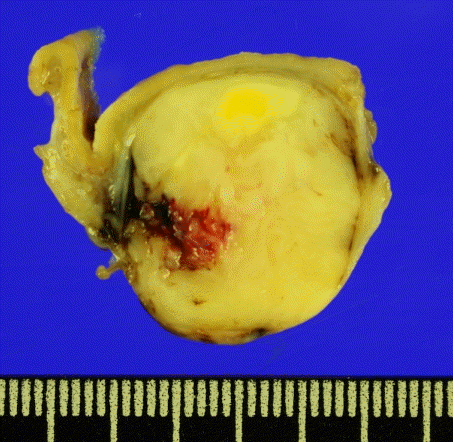Diagnosis of Gastric Subepithelial Tumor: Role of Endoscopic Ultrasound-Guided Fine-Needle Biopsy
Article information
Quiz
A 59-year-old woman presented with an incidental finding of a gastric subepithelial tumor (SET) (Fig.1A). The tumor appeared round in shape at the fundus of the stomach without ulceration. On endoscopic ultrasonography (EUS), the tumor measured 2.4 ×2.3 cm and had a heterogenous hypoechoic appearance in the proper muscle layer (Fig. 1B). EUS-guided fine-needle biopsy (EUS-FNB) was performed for the tumor (Fig. 1C, Fig. 2).

(A) A 3-cm sized subepithelial tumor was noted at the fundus of the stomach. (B) Endoscopic ultrasonography showed a 2.4×2.3 cm round, hypoechoic mass in the proper muscle layer. (C) Endoscopic ultrasound-guided fine needle biopsy was performed.

Pathologic findings of the biopsy specimens. (A) Histopathological examination reveals uniform spindle cells with high cellularity (hematoxylin and eosin ×200). (B) The tumor cells are strongly and diffusely positive for CD117 (×200).
What is the most probable diagnosis?
Answer
After EUS-FNB, the patient was diagnosed with a gastrointestinal stromal tumor (GIST). She finally underwent laparoscopic wedge resection (Fig. 3).
Gastric SETs are heterogeneous in nature, most frequently correspond to benign or premalignant neoplasms, and rarely to overtly malignant tumors. When considering the diversity and prognosis of SETs, obtaining sufficient tissue samples for pathologic confirmation is helpful in determining the treatment direction. The most representative histological findings of SETs are GIST and leiomyoma. When diagnosed with GIST, there is a malignant potential; therefore, endoscopic or surgical removal is performed, and if leiomyoma is diagnosed, follow-up observation is conducted. Hence, the differential diagnosis of the two lesions is clinically important.
EUS-FNB is a representative noninvasive method for acquiring tissue from gastric SETs [1]. Moreover, it was developed to improve the maintenance of tissue architecture, which can increase the diagnostic yield [2]. Immunohistochemical staining is essential for differentiating malignant SETs from benign SETs. The advantage of EUS-FNB is its high tissue yield for immunohistochemical staining and a high technical success rate owing to the needle flexibility. The yield rate of macroscopically optimal core sampling and diagnostic sufficiency rate of EUS-FNB for gastrointestinal SETs were reported to be 92% and 75%, respectively [3].
EUS-FNB is a good method for tissue diagnosis when gastric SETs are suspected based on endoscopy. The results of the EUS-FNB are very helpful in determining the direction of treatment by distinguishing between lesions that do and do not require resection, such as GIST and leiomyoma, respectively.
Notes
Conflicts of Interest: The authors have no potential conflicts of interest.

